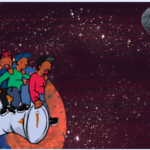Overview
This activity will use images from the story book “Trip to the Moon” written by Vera Evic, an author from Pangnirtung, Nunavut. Students will animate the images and create a scene from the book where kids use an oil drum rocket to travel to the moon. Students will learn about apparent motion and animation using a low tech activity, and then dive into a Scratch lesson to learn how to manipulate sprites and backdrops to create a scene, and connect blocks to create scripts that animate those sprites.
Learning Goals
This coding activity will familiarize students with the Scratch program, teaching them about sprites and backdrops, and introduce the basics of animation and sprite movement. Animation is vital to the creation of most games and provides a level of immersion that still images cannot.
Vocabulary
- Animation – A series of images that tricks the brain into thinking that movement is occurring.
- Sprite – A computer graphic that can move independently of the backdrop.
- Backdrop – A static or moving image providing background scenery.
- Code – A list of instructions for a computer to follow.
- X & Y Coordinates – A way of indicating location on a visible or invisible grid. X indicates horizontal location and Y indicates vertical location.
Guiding Questions
- Have you ever wanted to make a character move in a video game?
- How do we make a character in a video game move from one side of the screen to the other?
Curriculum Links
This module provides an opportunity to address curriculum expectations in the Science, Computer Studies, and Math in Grade 3-6 expectations. In particular, students will be learning different programming skills in Scratch and build on the skills they have learned in an entry-level assignment. This assignment will also demonstrate how visual cues can help communicate feelings, ideas, and understandings when telling a story.
